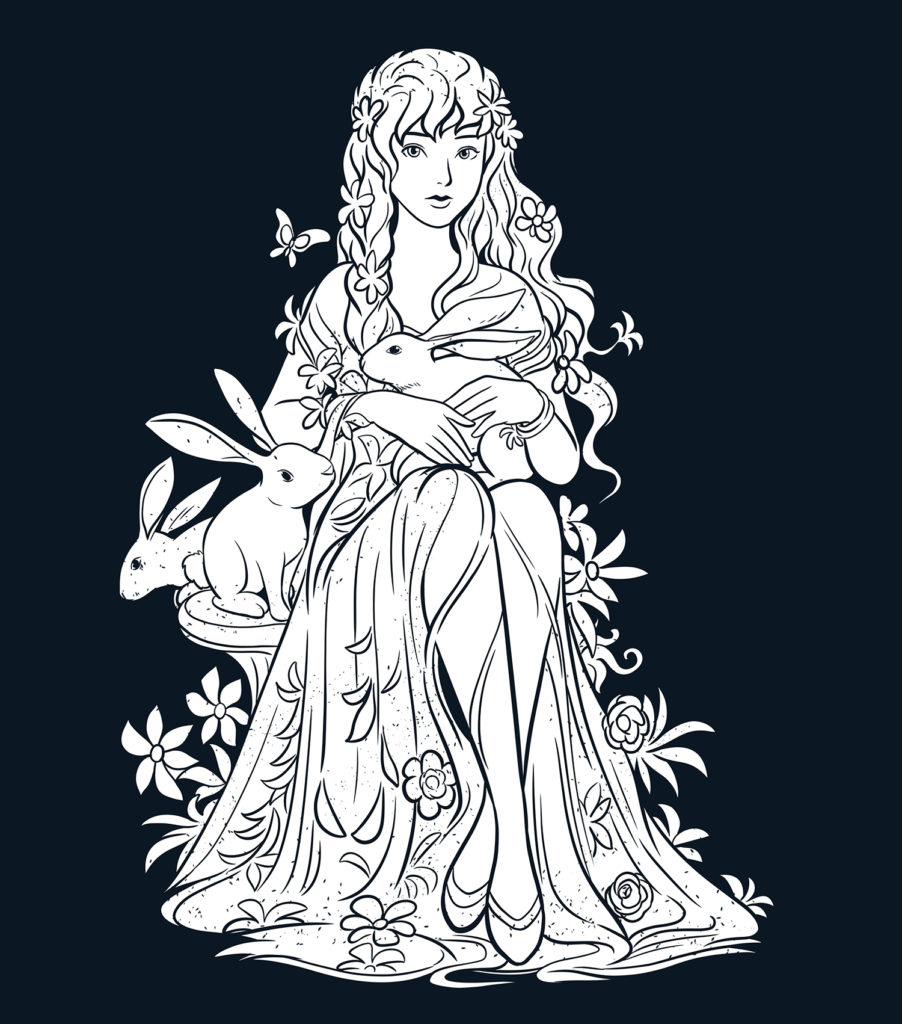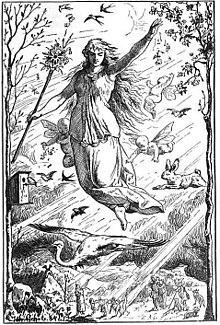
| Alternate Names: | Ēastre, Easter, Ēastro |
| Iconography: | Hares, Birds, Eggs, a Woman with a hare |
| Domains: | Fertility, Sex, Planting |
Historical Attestations
Called Ēastre in some dialects, and in others Ēastro, this famous Anglo-Saxon goddess is associated with Spring, and the East. In the lore of the English Saxons, her name is recorded but once, by the English churchman, Bede. Despite this, her name survives in many folk-tales and folk traditions, as well as being so deeply ingrained in the English “collective unconscious” that her name continues to be attached to the Christian Paschal holiday, which is certainly not the case in other parts of the world. Her name to many symbolizes Spring and fecundity, and calls to mind hares and hidden eggs, even among Christians, whose theology and usual iconography give no inkling as to how such motifs could be at home In their belief system. This argues for the existence of a powerful and famous fertility goddess , still dimly remembered despite attempts to absorb her symbols and name into the mythology of the resurrection of Christ. In his brief note on the subject of Easter and her festival, Bede tells us1De ratione temporum 15. (The reckoning of time, tr. Faith Wallis, Liverpool University Press 1988, pp.53-54):
…osturmonath has a name which is now translated “Paschal month”, and which was once called after a goddess of theirs named Eostre, in whose honour feasts were celebrated in that month. Now they designate that Paschal season by her name, calling the joys of the new rite by the time-honoured name of the old observance.
This singular and skeletal attestation was enough to pique the interest of the folklorist, Jacob Grimm, who found the reference to a Goddess of the Spring plausible enough, and went as far as reconstructing the name “Ostara” for an earlier continental form of the name from which Ēostre must have been derived. Later in the 19th century, fellow folklorist Charles Bilson agreed with Grimm’s observations, noting2Billson, Charles J. (1892). “The Easter Hare” as published in Folk-Lore, Vol. 3, No. 4 (December 1892):
that it would be uncritical to saddle this eminent Father of the Church, who keeps Heathendom at arms’ length and tells us less of than he knows, with the invention of this goddess.”

Of course, during the 19th century, many German authors, antiquarians and folklorists were being swept up in a wave of Germanic Romanticism, that sometimes created political, philosophical or scholastic biases that manifested in scholarly works on the subject of mythology during the period. Scholars would debate the accuracy of Bede’s account, and yet folklore concerning this Spring Goddess and her bird/hare messenger would persist, even growing in popularity. In The Folk-lore Journal, Volume 1, published in 1883, one H Krebs reported3R. Oberle’s Ueberreste germanischen Heidentums im Christentum, 8vo, Baden-Baden, 1883, (p. 104.):
Easter-Eggs and the Hare.—Some time ago the question was raised how it came that, according to South German still prevailing folk-lore, the Hare is believed by children to lay the Easter-eggs. I venture now to offer a probable answer to it. Originally the hare seems to have been a bird which the ancient Teutonic goddess Ostara (the Anglo-Saxon Eàstre or Eostre, as Bede calls her) transformed into a quadruped. For this reason the Hare, in grateful recollection of its former quality as bird and swift messenger of the Spring-Goddess, is able to lay eggs on her festival at Easter-time.
The source being cited, Überreste germanischen Heidentums im Christentum: Oder, die Wochentage by K.A. Oberle does indeed include the foregoing passage in the original German, almost word for word. Still, no connection had been firmly made between Anglo-Saxon Ēostre, and this continental goddess to which 19th Century folklorists were apt to allude.
Then, in 1958, archaeologists began to unearth votive inscriptions, near the German city of Bonn, dedicated to the Matronae Austriahenae, goddesses or “mothers” Austriahenae. These were dated to the 2nd Century AD. The first part of this compound word Austriahenae is derived from *Austra, the precise, Proto-Germanic cognate of Ēostre that Grimm had reconstructed, although he had already died by this point in time, and could not have known of the inscriptions. The second part of the word, henna/henae is used in connection with, and in the names of, Germanic mother goddesses, such as Baduhenna. These mother goddesses, known by the Latin term matronae (and in Ingwine Heathenship being considered synonymous with OE Idesa) are often associated with fertility, bountiful harvest, and prosperity, areas well within the portfolio typically aligned with Ēostre. This would if nothing else, seem to imply the worship of one or more fertility goddesses in the area of the Rhine, as early as the Second Century, who were in some sense connected with the East, and/or with our own goddess, Ēostre, at least etymologically.
Ingwine Guidance

In light of this evidence, it is the belief of the author, that Ēostre is indeed a goddess of Germanic antiquity, and one who was invoked as described by Bede, for a good harvest and bountiful growing season, during the time roughly correlating with the modern month of April, during the lunar month known as Ēosturmōnaþ in Old English, or Ôstarmânoth in Old High German. It may be advisable too, to seek her good graces in matters of romantic love, or conception.
With respect to the folk-lore surrounding the Easter Hare and/or birds, it may be that songbirds and hares are indeed sacred to this goddess, as the hare is of course fecund, and a plausible enough symbol of carnal love and fertility, while migratory birds would return to northern climates with the return of Spring. So, we may say with some confidence that in modern Ingwine Heathenship, it would be auspicious to invoke Ēostre in matters of love, fertility, planting, and prosperity. Among the Easter traditions that survive into the modern Era, those surrounding Easter Eggs and the “Easter Bunny” are possibly the most well known in Anglophone nations, but other remembrances of this Goddess and her eponymous Spring festival survive in Europe, that may also be ancient in origin, surviving fragments of the cult of Easter. Today, throughout Germany and the Netherlands, there remain traditions of burning Easter bonfires, so the Earth may be warmed, and the last vestiges of Winter driven away. Fire can be a potent symbol of renewal and rebirth, and it is thought that the light of these bonfires would quicken the fields that the light reached.
The holiday traditions of dyeing, hiding, seeking and eating eggs, while difficult to trace to any certain time or place, would certainly seem Germanic in origin and entirely appropriate ways to celebrate the Feast of Easter today. Hot-Cross buns baked at Easter, are a particularly Anglo-Saxon (or at least English) custom, and one that very likely does have its roots in Heathen celebrations, as the giving of bread or cakes as votive offerings is attested elsewhere in Anglo-Saxon tradition, and would seem entirely agreeable at a celebration of the Spring Goddess.

